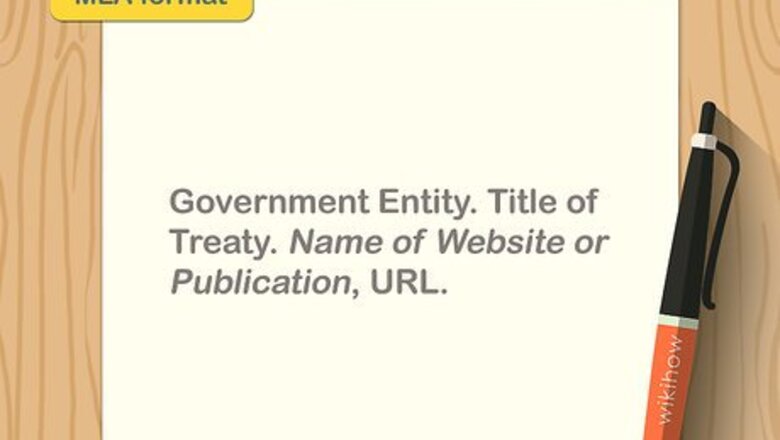
views
X
Trustworthy Source
Purdue Online Writing Lab
Trusted resource for writing and citation guidelines
Go to source
MLA
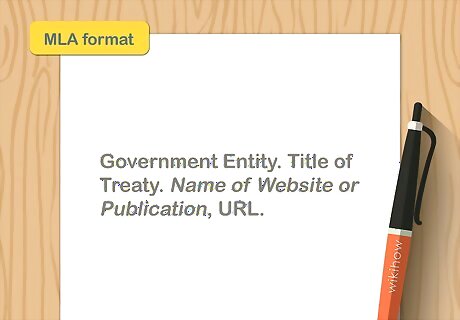
Start with the government entity as the author. If you accessed the treaty through a government website, that government entity is the author. List the country first followed by a comma, then the specific government division that ratifies the treaty. Place a period at the end. For example, in the US, the Senate ratifies treaties, so the Senate would be considered the author of the treaty. If you accessed a treaty through the Senate's website, you would list the author as "United States, Senate." If the treaty wasn't authored by a specific country, start your Works Cited entry with the title of the treaty, rather than an author.
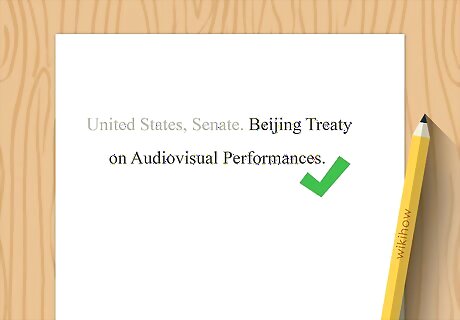
Include the title of the treaty in regular font. Type the name of the treaty in title case, capitalizing the first word and all adjectives, nouns, pronouns, verbs, and adverbs in the title. Place a period at the end. Example: United States, Senate. Beijing Treaty on Audiovisual Performances.
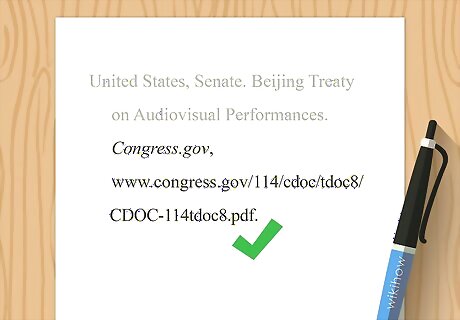
Provide the name of the publication and a URL, if appropriate. In MLA style, you direct your readers to the exact copy of the treaty that you read when you were writing your paper. If it appeared in a book or on a website, include the name of that work in italics. If you accessed the treaty online, type a comma after the name and then copy the permalink URL for the treaty in regular font. Do not include the "http://" portion of the URL. Place a period at the end of the URL. Example: United States, Senate. Beijing Treaty on Audiovisual Performances. Congress.gov, www.congress.gov/114/cdoc/tdoc8/CDOC-114tdoc8.pdf.
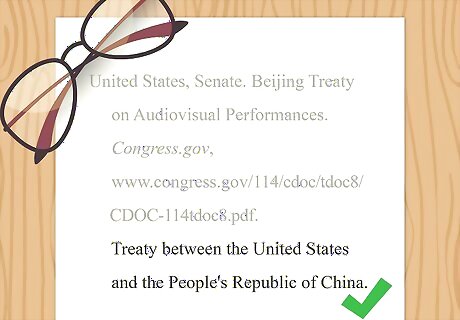
Close with a brief description of the document. Indicate that the document you're citing is a treaty, even if the word "treaty" is included in the title. For a bilateral treaty, state the 2 parties to the treaty. Otherwise, state that it is a "Multilateral treaty." Place a period at the end of your description. Example: United States, Senate. Beijing Treaty on Audiovisual Performances. Congress.gov, www.congress.gov/114/cdoc/tdoc8/CDOC-114tdoc8.pdf. Treaty between the United States and the People's Republic of China. MLA Works Cited Format: Country, Government Division. Title of Treaty. Name of Website or Publication, URL. Description of Treaty.
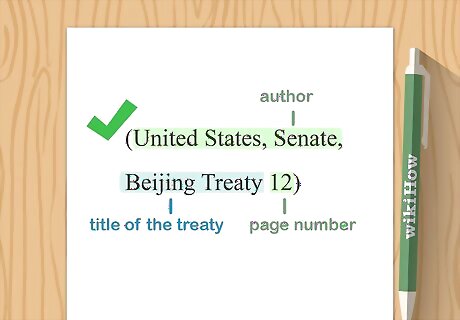
Use your in-text citation to direct your reader to the Works Cited entry. For MLA in-text citations, you typically would place a parenthetical that included the last name of the author and the page number where the material appears at the end of any sentence in which you referenced the source. However, this formula may not work for treaties. In most cases, using the first few words of the Works Cited entry is sufficient for your readers to find the correct full citation. For example, if you're talking about the Beijing Treaty, simply including "United States, Senate" wouldn't work by itself – particularly if you've also used other treaties or government documents as sources. Instead, your parenthetical might be "(United States, Senate, Beijing Treaty 12)." If the copy of the treaty you used as a source is not paginated, do not include any number in your parenthetical citation. If you mention the name of the treaty in your text, you may not need a parenthetical citation at all. However, if the treaty is paginated, you would still need a parenthetical with the page number where the material you quoted or paraphrased appears.
APA/Bluebook
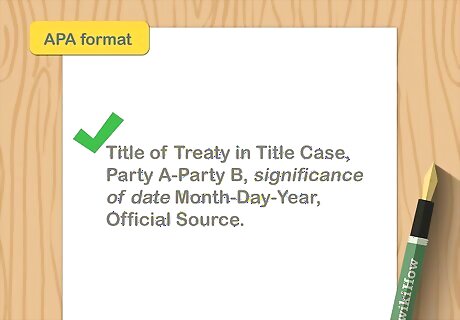
List the full title of the treaty first. Start your reference list entry with the full title of the treaty. Write in title case, capitalizing the first word and all adjectives, adverbs, nouns, pronouns, verbs, and words with more than 4 letters. Place a comma at the end of the title. Example: Treaty Concerning Pacific Salmon,
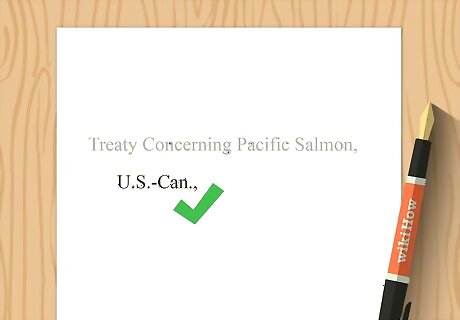
Provide the names of the parties to the agreement. If the treaty is bilateral, include an abbreviated form of each party to the agreement, separated by hyphens. If there are more than 2 signatories, you have the option of including them or omitting them. The standard rule is that if the U.S. is a party to the treaty, you list the U.S. first, followed by other signatories in alphabetical order. If the U.S. is not a party to the treaty, list the signatories in alphabetical order. Place a comma after the last country listed. Example: Treaty Concerning Pacific Salmon, U.S.-Can., Appropriate abbreviations for geographical terms are included in Table 10 of the Bluebook. If you can't find a Bluebook at a local library, search online for citations to the treaty using an academic search engine, such as Google Scholar. Find a legal citation and copy their abbreviations.
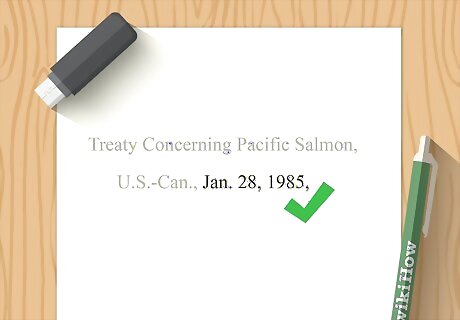
Include the date that the treaty was signed. Write the date in month-day-year format, abbreviating months with more than 4 letters. Place a comma after the date. If the parties signed on different dates, provide the date the treaty was opened for signature, adopted, or approved. Write the significance of the date in italics before the date. Example with signature date: Treaty Concerning Pacific Salmon, U.S.-Can., Jan. 28, 1985, Example without signature date: Vienna Convention on the Law of Treaties, opened for signature May 23, 1969,
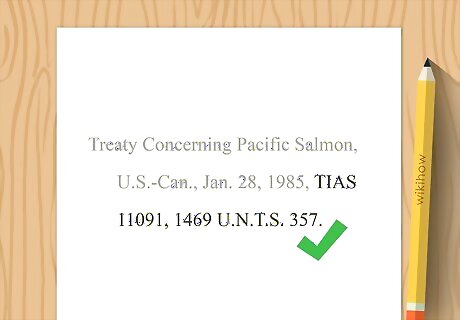
Close with the source of the treaty. When using APA or Bluebook citation format, you must cite to an official source that publishes texts of treaties. Some of these sources have volumes and page numbers while others use item numbers. Place a period at the end of the information about the source. If the source has an item number, type the initials for the source followed by the item number. For example: Treaty Concerning Pacific Salmon, U.S.-Can., Jan. 28, 1985, TIAS 11091. If the source has volumes and page numbers, type the volume number followed by the abbreviation for the source. Then type the page number on which the treaty starts. For example: Treaty Concerning Pacific Salmon, U.S.-Can., Jan. 28, 1985, 1469 U.N.T.S. 357. Major official sources include United States Treaties and Other International Agreements (U.S.T.), Treaties and Other International Acts Series (TIAS), and United Nations Treaty Series (U.N.T.S.). APA/Bluebook Citation Format: Title of Treaty in Title Case, Party A-Party B, significance of date Month-Day-Year, Official Source.
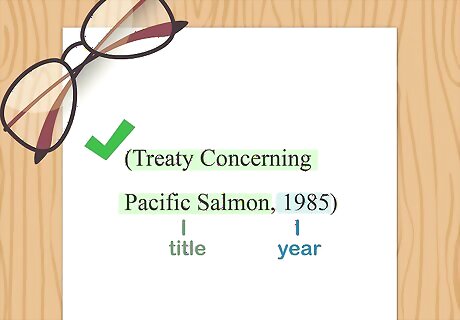
Use the title of the agreement and the year for in-text citations. At the end of any sentence in which you quote or paraphrase the treaty, include a parenthetical citation with the title of the treaty, followed by a comma. Add the year that you included in your citation. The parenthetical citation goes inside your closing punctuation. Example: (Treaty Concerning Pacific Salmon, 1985). If the title of the treaty is long, you may want to include it in the text of your paper rather than in a parenthetical, where it might be distracting for readers. If you list the full title of the treaty in your text, place the year in parentheses immediately after it. If you're writing a paper using the Bluebook method, include the full citation in footnotes. You typically don't have a reference list or bibliography at the end of a Bluebook paper.
Chicago/Turabian

Type the title of the treaty in double quotation marks. Open your bibliographic entry with the title of the treaty. Use title case, capitalizing all adjectives, adverbs, nouns, pronouns, and verbs. Place a period at the end, inside the closing double quotation marks. Example: "Treaty on the Non-Proliferation of Nuclear Weapons."
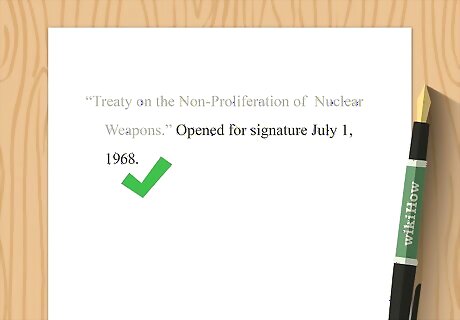
Provide the date the treaty was signed. List the date in month-day-year format. Do not abbreviate any months. If there's no single date of signing, type a description of the significance of the date used before the date. You can use the date the treaty was opened for signature, approved, ratified, or adopted. Place a period at the end of the date. Example: "Treaty on the Non-Proliferation of Nuclear Weapons." Opened for signature July 1, 1968.

Include publication information for the source. Type the title of the source you used to access the text of the treaty in italics followed by a comma. Include any volume or item numbers for the source, then place the year of publication in parentheses. Place a colon after the closing parentheses, then provide the page range where the treaty can be found within the source. Place a period after the final page number. Example: "Treaty on the Non-Proliferation of Nuclear Weapons." Opened for signature July 1, 1968. Treaty Series: Treaties and International Agreements Registered or Filed and Recorded with the Secretariat of the United Nations 729, no. 10485 (1974): 161-299.
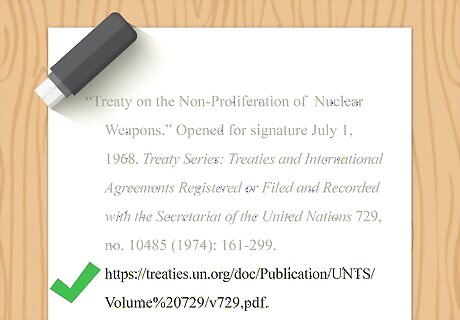
Close with a URL, if appropriate. If the source has a copy of the URL on its official website, copy the direct link to the treaty at the end of your citation. This will make it easier for your readers to access the text of the treaty. Place a period at the end of the URL. Example: "Treaty on the Non-Proliferation of Nuclear Weapons." Opened for signature July 1, 1968. Treaty Series: Treaties and International Agreements Registered or Filed and Recorded with the Secretariat of the United Nations 729, no. 10485 (1974): 161-299. https://treaties.un.org/doc/Publication/UNTS/Volume%20729/v729.pdf. Chicago Bibliography Format: "Title of Treaty in Title Case." Description of significance of date Month Day, Year. Title of Source that Contains Treaty Text Vol, item # (Year): Page numbers. URL.

Use commas instead of periods to separate elements in footnotes. When you reference the treaty in the text of your paper, place a superscripted number at the end of the sentence outside the closing punctuation. The footnote has the same information as the entry in your bibliography, but elements are separated with commas instead of periods. The only period in the footnote is at the end. Example: "Treaty on the Non-Proliferation of Nuclear Weapons," opened for signature July 1, 1968, Treaty Series: Treaties and International Agreements Registered or Filed and Recorded with the Secretariat of the United Nations 729, no. 10485 (1974): 161-299, https://treaties.un.org/doc/Publication/UNTS/Volume%20729/v729.pdf. If you're citing the treaty as a whole in the footnote, include the full page range. Otherwise, cite directly to the page or page range where the material you quoted or paraphrased in your text can be found.

















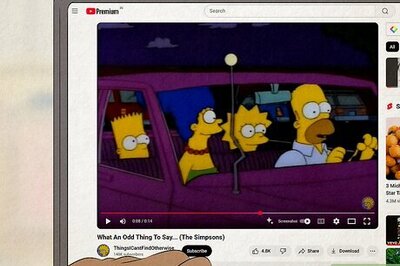
Comments
0 comment